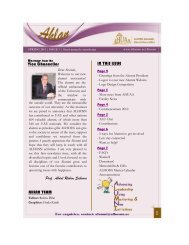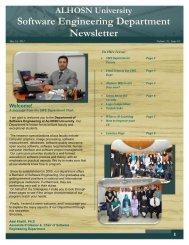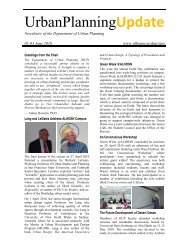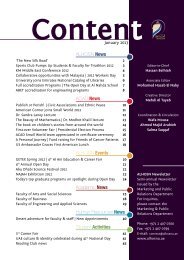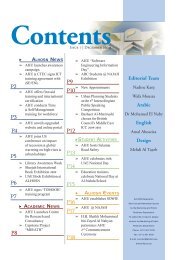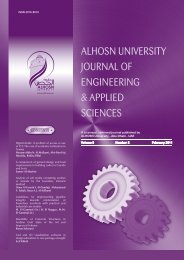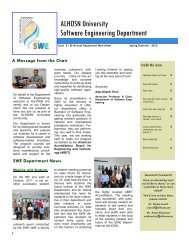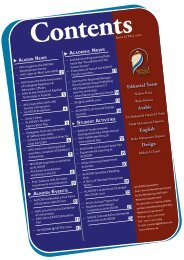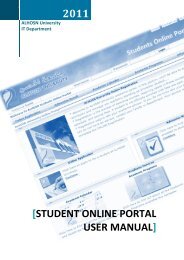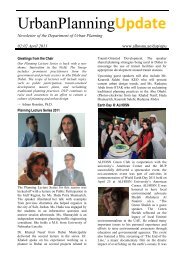ALHOSN University Catalogue Global Knowledge with Local Vision ...
ALHOSN University Catalogue Global Knowledge with Local Vision ...
ALHOSN University Catalogue Global Knowledge with Local Vision ...
Create successful ePaper yourself
Turn your PDF publications into a flip-book with our unique Google optimized e-Paper software.
4. Cultivate an awareness of the design influences of contemporary societies, their impact on<br />
the built form, and future directions.<br />
5. Develop a wide vocabulary of techniques to explore design solutions (2-D and 3-D graphics<br />
and spatial comprehension, color, texture, lighting).<br />
6. Develop the ability for analytical thinking as a means of addressing architectural problems<br />
through research, data collection, and analysis of information leading to a clear understanding<br />
of the problem.<br />
7. Develop an ability to contribute constructively to a team effort in group learning situations.<br />
8. Introduce nature and the use of materials, construction assemblies and methodologies that<br />
define the building envelope.<br />
9. Acknowledge structure as an integral component of architectural design and become fully<br />
conversant <strong>with</strong> structural engineering principles applied to the built form.<br />
10. Become knowledgeable regarding the building services (mechanical, electrical systems).<br />
11. Become aware of the parameters involved in the preservation, renovation, and conversion<br />
of architectural structures.<br />
12. Instill in the student a sense of social responsibility: the preservation of the biosphere as well<br />
as responding to other social priorities (handicap accessibility, homelessness, cultural heritage,<br />
etc.).<br />
13. Introduce issues of legal responsibilities, professional and business ethics, the building codes,<br />
by- laws, zoning and other elements pertaining to a professional practice.<br />
14. Introduce the financial and business management aspects of an architectural practice.<br />
15. Introduce the role of professional associations in the architectural practice.<br />
Program Outcomes<br />
Upon completion of this program, graduates should be able to:<br />
a. Recognize current best practices and contemporary issues in architectural engineering.<br />
b. Apply the techniques, skills, and modern architectural theories and tools necessary for<br />
professional practice.<br />
c. Analyze and interpret data in different contexts.<br />
d. Recognize the architect’s role as the privileged interlocutor of the client, users, contractors<br />
and society.<br />
e. Identify the clients’/users’ needs and model architectural alternatives in response to them.<br />
f. Recognize the professional and ethical responsibilities of architectural engineers.<br />
g. Understand the impact of architectural structures in a global and societal context.<br />
h. Participate creatively in multi-disciplinary professional teams and positively influence the<br />
quality of the built environment.<br />
i. Pursue graduate studies in architecture, or urban planning.<br />
Curriculum<br />
The Architectural Engineering curriculum requires a minimum total of 138 credit hours. Out of these<br />
138 hours, twenty-four (24) credit hours are for courses under the <strong>University</strong> General Education, in<br />
which 18 are compulsory and 6 are electives. The compulsory UGEs are: FAS 100, FAS 101, FAS<br />
102 or 109, FAS 103, FAS 108, FBA 100. The <strong>University</strong> General Electives could be taken from the<br />
following list: FAS 105, FAS 106, FAS 107, FAS 109, FES 103, FES 280, FES 281, FES 282, FBA<br />
102. Eighteen (18) credit hours are for courses under the Faculty Requirements, all of which are<br />
compulsory. There are ninety-six (96) credit hours for courses under the program requirements (87)<br />
Compulsory and (9) Electives.<br />
The course schedule below, organized over four years is illustrative for Architectural engineering<br />
students who enter directly from high school. Transfer students, <strong>with</strong> the help of their advisors, will<br />
adjust according to their individual needs.<br />
87



